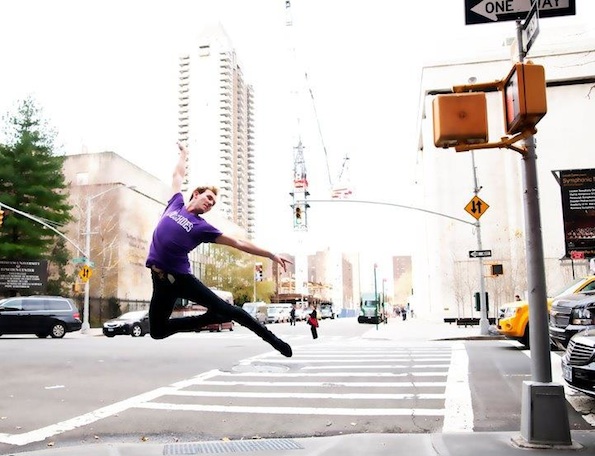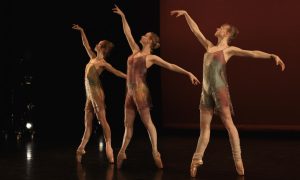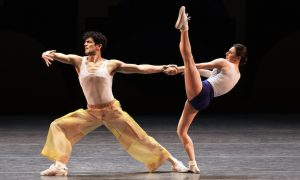By Laura Di Orio.
They say taking class is like brushing your teeth. So that must mean that stretching or warming up beforehand is like flossing.
Getting one’s body ready for a long day of rehearsals or performances is important for dancers and may help prevent injury, increase energy level and make for a happier body long-term. Of course, with experience and trial-and-error, each dancer may find what works best for him/her.
Here, Dance Informa speaks with some professional dancers about their pre-class routines.
What is your pre-class routine?
Oliver Swan-Jackson, Freelance Dancer in NYC and with The Suzanne Farrell Ballet
I aim to get to class at least 30 minutes early to start my warm-up. Obviously with transportation issues that isn’t always the case. I tend to wear a lot of warm-up clothes, especially during the winter or in a colder theater, but tend to take them all off during barre. My warm-up starts off with circling my ankles, hips and shoulders and cracking or popping my back and hips to ease out any kinks. I then stretch out my quads, hamstrings, glutes and lower back before, if I have time, doing some sit-ups and push-ups.
Allison DeBona, Demi-Soloist at Ballet West and featured dancer on the CW’s reality series Breaking Pointe (follow on Twitter @allidebona)
I have two dogs, and it’s hard to get moving and get to class super early! I walk my dogs in the morning to get moving and arrive at class with usually 10 minutes to spare. The main part of my body that feels the tightest in the mornings are my hip flexors. I have to make sure to stretch my hips and thighs every day before class.
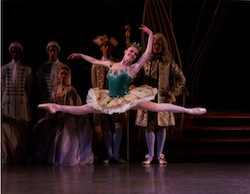
NYCB Soloist Lauren King, here in Peter Martins’ ‘The Sleeping Beauty’, feels a morning routine helps her focus mentally and physically. Photo by Paul Kolnik.
Lauren King, Soloist at New York City Ballet
Before a long day, I always make sure I start off with a good breakfast. I usually have company class in the morning at 10:30, so I like to get to class 30 minutes before it starts to do some light stretching and warm up my joints with a little Gyrokinesis, in addition to exercising my muscles I need to strengthen.
Sean Patrick Mahoney, Dancer at Paul Taylor Dance Company
The weather has a huge effect on my pre-class routine. If it’s a beautiful day, I’ll ride my bike from my apartment in Brooklyn to the studio. I like to get to the studio on the early side to settle down, have some tea and take my time getting changed. Starting off the day in a relaxed state of mind is really important. Before class, I’ll take about 20 minutes to do some core strengthening, followed by stretching.
Devin Alberda, Corps de Ballet at New York City Ballet
I usually try to get to class at least 10 minutes before it starts. I do some stabilization, some ab work, some push-ups and then tend to anything that might feel tight or stuck with light massage and stretching.
How does this routine help prepare you for a long dance day? And how do you feel if you’re unable to do this routine?
Allison DeBona
Since my mornings are so busy with my pups, pliés at the barre have evolved into less of a classical technique experience. I’m the one in class circling my head during pliés in first and circling my arms to get my shoulders to open up. I also like to stretch turned in at first to get my hamstrings loosened up. I’ve found that if I don’t do this and keep my pliés rigid, the rest of barre feels different.
Sean Patrick Mahoney
If I didn’t take the time to prepare my body for the day, I’d feel like I was playing catch up with my brain. My brain knows that I need to jeté from center and land past the quarter mark into a back roll, but if my body isn’t prepared, there’s that awkward moment, just a split second, when I need to figure out how to accomplish the task without hurting myself. Not having to worry about things like that help me to find those amazingly enjoyable moments in the air.
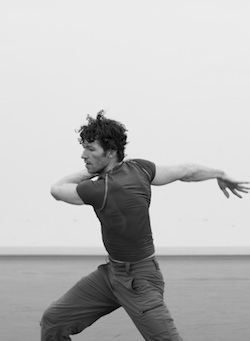
Sean Patrick Mahoney of Paul Taylor Dance Company likes to start his day in a relaxed state of mind. Photo by Francisco Graciano.
Lauren King
Having a morning routine helps me focus mentally and physically and prepares me for whatever the day may bring.
Oliver Swan-Jackson
The main benefit for me is to ease myself into a long day and not go overboard. Throughout a long rehearsal day, I continue with my stretching, sit-ups and push-ups. On the days when I am running late and have to rush into class at the last minute, I usually feel sluggish for the class, and I feel as if my body doesn’t respond as well as I would like.
When and why did you establish this routine?
Devin Alberda
I started when my body got old and I couldn’t get away with not warming up anymore. I want to say I was 23?
Oliver Swan-Jackson
The warm-up is loosely based on a warm-up taught to me by one of my first ballet teachers, and it focused on breathing and placement of the body. Over the years, I have adapted it to suit my personal needs in the morning – focusing more on warming up my hip and ankle joints.
Allison DeBona
My stretching and class work has changed a lot in the past few years. I never have a rehearsal day that is less than six hours. Stretching has become less of a flexibility enhancer and more of a way to keep my body maintained and healthy.
What has been beneficial for you before class that may serve as advice for aspiring dancers?
Lauren King
Having time before class to stretch and feel a mental and physical connection always helps me focus and feel more aware of my body in class and throughout the day.
Allison DeBona
Eat breakfast!
Oliver Swan-Jackson
I definitely recommend getting to class early to warm up. As I have gotten older, I have noticed that it gets much harder to get ready each morning. Plus, it can help reduce the risk of injuries.
Sean Patrick Mahoney
Be flexible and open-minded. ‘Routine A’ won’t always work. When trying to establish a pre-class warm-up, find someone with a similar body type. Ask questions. Compare notes. And for the sake of sanity, find someone to help pass the time. I’m surrounded by colleagues who have their own routines. But what makes the early mornings more enjoyable is the fact that we enjoy each other’s company while we warm up.
Photo (top): Dancer Oliver Swan-Jackson is a freelance dancer in NYC and can be seen performing with The Suzanne Farrell Ballet. He typically arrives to class 30 minutes early to stretch and warm up. Photo by Brian Mengini.


